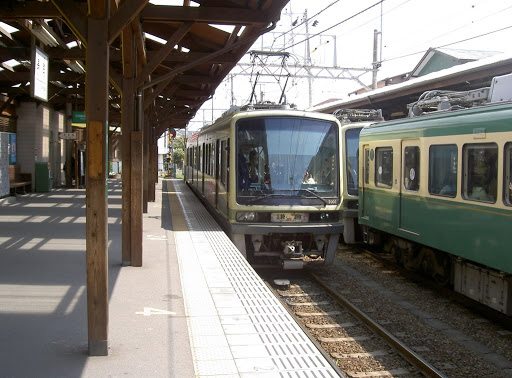 Inside the cave locals placed their coins in the small wicker baskets and ladled the Zeniarai Benten shrine’s spring waters over the basket, soaking the money. Legend says that the money will be bring great returns once spent.
Inside the cave locals placed their coins in the small wicker baskets and ladled the Zeniarai Benten shrine’s spring waters over the basket, soaking the money. Legend says that the money will be bring great returns once spent.
As Australians we had a great advantage over the locals. A plastic fifty dollar note. No worries getting that wet!
The Odakyo Line’s rapid express to Fujisawa was a glorified suburban train with squashed inward facing seats. Not great for sightseeing, but the departure point was close to the hotel. After yet another late night that was very important as it meant we could wake up that much later (but still too early).
 At Fujisawa we changed to a tramway called the the Enoshima Dentetsu or Enoden line. This is a cute little train that runs through a narrow path, giving passengers a good view of some lovely little house gardens. After Enoshima the Enoden line runs along the coast. We watched locals attempting to surf in near non-existent waves. They were probably too busy enjoying the sunny weather to care.
At Fujisawa we changed to a tramway called the the Enoshima Dentetsu or Enoden line. This is a cute little train that runs through a narrow path, giving passengers a good view of some lovely little house gardens. After Enoshima the Enoden line runs along the coast. We watched locals attempting to surf in near non-existent waves. They were probably too busy enjoying the sunny weather to care.
Disembarking at Hase station we walked up to the Hasedera temple, with its large wooden “kannon” (Buddha statue). The temple gardens are very pretty with many spring flowers and a wonderful view across the bay.
A lunch of soba noodles, tempura and rice recharged the batteries. It’s the first time we have had both on this trip to Japan. Last time I went crazy over soba, especially the cold zaru soba.
 The Daibatsu, an 11 metre high bronze statue of Buddha was not as impressive as the Lantau island statue in Hong Kong, although its history is more interesting. It was originally enclosed within a wooden temple, but this was washed away in a tsunami.
The Daibatsu, an 11 metre high bronze statue of Buddha was not as impressive as the Lantau island statue in Hong Kong, although its history is more interesting. It was originally enclosed within a wooden temple, but this was washed away in a tsunami.
After one false start we took the Daibatsu hiking course northwards. The initial steep steps upwards were daunting, but the serenity and beauty of the surroundings quickly overcame the misgivings. The path wound its way up along the hill ridges, thick exposed tree roots a constant tripping hazard.
We passed under green and red maples, pink cherry blossoms and a forest of cyprus pines. Above us falcons circled, while other birds sung a constant symphony. It was one of the most enjoyable experiences I have had in Japan.
 The trail emerged into a quaint (and undoubtedly expensive) little community with spectacular views over the ocean. The Kuzuharaoka Jinja marked the end of our walk along the trail, the shrine appearing to be more of a picnic spot and blossom appreciation location than place of religious significance.
The trail emerged into a quaint (and undoubtedly expensive) little community with spectacular views over the ocean. The Kuzuharaoka Jinja marked the end of our walk along the trail, the shrine appearing to be more of a picnic spot and blossom appreciation location than place of religious significance.
The road down to the Zeniarai Benten shrine was steep and guaranteed that we were not climbing back up. There we washed our fifty dollar note and admired the huge koi. You don’t see koi that size in China it seems. Probably eaten.
 One more shrine interrupted our walk to Kamakura station: the Sasuke-jinja had a classic path of torii, though some were new and unpainted, while others had rotted away. The lead up to a peaceful set of shrines, adorned with many dog statues.
One more shrine interrupted our walk to Kamakura station: the Sasuke-jinja had a classic path of torii, though some were new and unpainted, while others had rotted away. The lead up to a peaceful set of shrines, adorned with many dog statues.
The Enoden line returned us from Kamakura to Fujisawa, from where we caught the train back to Shinjuku and a evening trip to Yodobashi Camera and a dinner of Japanese curry. No little laptops as cute as the one I’m typing on.
Kamakura is a really pretty place to visit. The Daibatsu trail provided a total contrast to the flashing lights and crowds of Shinjuku. There are many aspects to Japan and it’s well worth trying to explore as many as you can.
